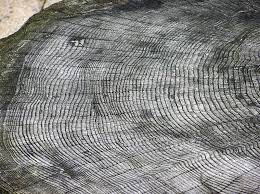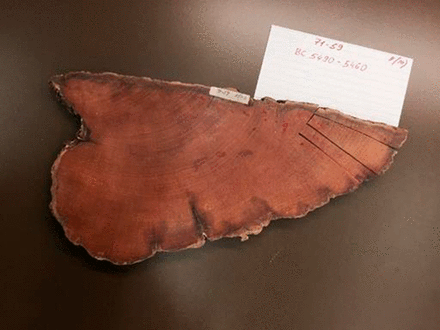New fine-tuning of radiocarbon dating can "rewrite" ancient events
"If it's organic and old -- up to 50,000 years -- you date it by radiocarbon," explains Sturt Manning, of Cornell University, Goldwin Smith Professor of Classical Archaeology in the College of Arts and Sciences the lead author of an article published in the scientific journal Nature - Science Advances, that points out the need for an important new refinement to the technique.The outcomes of his study, published March 18, 2020 in Science Advances, have relevance for understanding key dates in Mediterranean history and prehistory, including the tomb of Tutankhamen and a controversial but important volcanic eruption on the Greek island of Santorini.
Radiocarbon dating, invented in the late 1940s and improved ever since to provide more precise measurements, is the standard method for determining the dates of artifacts in archaeology and other disciplines.
Radiocarbon dating measures the decomposition of carbon-14, an unstable isotope of carbon created by cosmic radiation and found in all organic matter. Cosmic radiation, however, is not constant at all times. To account for fluctuations of cosmic radiation in the Earth's atmosphere, the radiocarbon content of known-age tree rings was measured backward in time from the 20th century, for thousands of years.

Tree-ring calibrated radiocarbon started to be widely used 50 years ago. A standard calibration curve was introduced in 1986 and is updated every few years as more data are added.
"A single Northern Hemisphere calibration curve has formed the basis of radiocarbon dating in Europe and the Mediterranean for five decades, setting the time frame for prehistory," Manning and co-authors write. "However, as measurement precision increases, there is mounting evidence for some small but substantive regional (partly growing season) offsets in the same-year radiocarbon levels."
In their study, Manning and co-authors question the accuracy of a single calibration curve for all of the Northern Hemisphere. Using data collected by only one lab to control for interlaboratory variation, they compared radiocarbon data from northern Europe (Germany) and from the Mediterranean (central Turkey) in the 2nd and 1st millennia B.C. They found that some small but critical periods of variation for Mediterranean radiocarbon levels exist. Data from two other radiocarbon labs on samples from central Italy and northern Turkey then provided consistency.
Growing seasons play a role, the paper says. The radiocarbon level on Earth varies according to the season; there's a winter low and a summer high, Manning said. The carbon in a tree ring reflects when the tree was photosynthesizing and, therefore, taking carbon out of the atmosphere.
"In northern Europe or in North America, a tree is going to be doing this in April through September. But a tree in Jordan or Israel does that October through April -- almost the opposite time of the year," he said.
These variations, although small, potentially affect calendar dates for prehistory by up to a few decades, the paper concludes.
Even small date offsets -- 50 years or less -- are important for building the timeline of the Mediterranean region, which, in the last two millennia B.C., was a hotbed of interrelated cultures.
The adjusted dates confirm previously awkward timelines, where radiocarbon and history did not seem to agree for some historical landmarks, including the death and burial of Egyptian pharaoh Tutankhamen, which is dated around the 1320s to 1310s B.C., according to recent Egyptology.
The study also addresses a debate over the date of a massive volcanic eruption on Santorini. This much-studied event is dated around 1500 B.C. by archaeologists but earlier -- 1630 to 1600 B.C. -- by scientists. Manning said the new findings rule out the date of 1500 B.C., but may also modify the science. A 1630-1600 B.C. date remains possible, but a later date in the range 1600-1550 B.C. now becomes plausible, and even works better with existing archaeological and historical records, including writings from Egypt.
The study also has ramifications for understanding which culture influenced the Minoans and Mycenaeans, which led to ancient Greece.
"Getting the date right will rewrite and get our history correct in terms of what groups were significant in shaping what then became classical civilization," Manning said. "An accurate timeline is key to our history."
He predicts follow-up on this study and a future with more specific regional calibration curves within the Northern Hemisphere -- as well as subsequent adjustment to historical dates.
Kate Blackwell
March 18, 2020
Tree-rings record intense cosmic radiation burst in 775 AD

Just over 1,200 years ago, the planet was hit by an extremely intense burst of high-energy radiation of unknown cause, scientists studying tree-ring data have found.
The radiation burst, which seems to have hit between AD 774 and AD 775, was detected by looking at the amounts of the radioactive isotope carbon-14 in tree rings that formed during the AD 775 growing season in the Northern Hemisphere. The increase in 14C levels is so clear that the scientists, led by Fusa Miyake, (pic.) a cosmic-ray physicist from Nagoya University in Japan, conclude that the atmospheric level of 14C must have jumped by 1.2% over the course of no longer than a year, about 20 times more than the normal rate of variation. Their study is published online in Nature.
"The work looks pretty solid," says Daniel Baker, a space physicist at the University of Colorado's Laboratory for Atmospheric and Space Physics in Boulder, Colorado. "Some very energetic event occurred in about AD 775."
Exactly what that event was, however, is more difficult to determine.
The 14C isotope is formed when highly energetic radiation from outer space hits atoms in the upper atmosphere, producing neutrons. These collide with nitrogen-14, which then decays to 14C. (The fact that this is always happening because of background radiation is what produces a continuous source of 14C for radiocarbon dating.)
Cosmic puzzle
The only known events that can produce a 14C spike are floods of γ-rays from supernova explosions or proton storms from giant solar flares. But neither seems likely, Miyake says, because each should have been large enough to have had other effects that would have been observed at the time.
A massive supernova, for example, should have been bright enough to produce a 'new' star visible even in the daytime, as was the case for two known supernovae in AD 1006 and AD 1054. Such an explosion would have needed to be brighter than either of these, Miyake says, because those events were not large enough to leave traces in the 14C record.
It is possible, she says, that the proposed event might have occurred in the far southern skies, where astronomers of the era wouldn't have seen it. But still, she says, if it did happen, today's X-ray and radio astronomers should have found signs of a "tremendously bright" remnant of the explosion.
As for solar flares, she says, anything that could have produced the required amount of super-high-energy protons would have vastly exceeded the most intense solar outburst ever recorded. There should have been a historical record of extraordinary auroras — not to mention that such a gigantic flare would probably have destroyed the ozone layer, with devastating ecological consequences.
Baker, however, thinks that Miyake's team may have been too quick to rule out a solar flare. Flares are sometimes associated with coronal mass ejections (CMEs) — huge eruptions of magnetically charged plasma from the Sun's atmosphere that send streams of charged particles towards Earth. It might be possible, he says, for CMEs to be accompanied by conditions in which an unusual number of protons are accelerated to super-high energies, even without the flare itself being "ridiculously strong".
"We know much more these days about how important proton acceleration is at the shock fronts that precede CME structures as they propagate towards Earth," Baker says. "I would like to think about whether a strong CME moving directly towards Earth could have produced the intense proton population that impacted Earth's atmosphere."
"It would be fascinating," Baker adds, "if there were some record in China or in the Middle East that reported powerful aurora or some other such event" around the same time as the observed 14C increase.
Richard E. Lovett
June 03, 2012
A highly abnormal Sun in the mid-Holocene - 5480 BC

What happened to the sun over 7,000 years ago? Analysis of tree rings reveals highly abnormal solar activity in the mid-Holocene
By analyzing the level of a carbon isotope in tree rings from a specimen of an ancient bristlecone pine, researchers have revealed that the sun exhibited a unique pattern of activity in 5480 BC. By comparing this event with other similar but more recent phenomena, they reported that this event may have involved a change in the sun's magnetic activity, or a number of successive solar burst emissions.
An international team led by researchers at Nagoya University, along with US and Swiss colleagues, has identified a new type of solar event and dated it to the year 5480 BC; they did this by measuring carbon-14 levels in tree rings, which reflect the effects of cosmic radiation on the atmosphere at the time. They have also proposed causes of this event, thereby extending knowledge of how the sun behaves.
When the activity of the sun changes, it has direct effects on the earth. For example, when the sun is relatively inactive, the amount of a type of carbon called carbon-14 increases in the earth's atmosphere. Because carbon in the air is absorbed by trees, carbon-14 levels in tree rings actually reflect solar activity and unusual solar events in the past. The team took advantage of such a phenomenon by analyzing a specimen from a bristlecone pine tree, a species that can live for thousands of years, to look back deep into the history of the sun.
"We measured the 14C levels in the pine sample at three different laboratories in Japan, the US, and Switzerland, to ensure the reliability of our results," A. J. Timothy Jull of the University of Arizona says. "We found a change in 14C that was more abrupt than any found previously, except for cosmic ray events in AD 775 and AD 994, and our use of annual data rather than data for each decade allowed us to pinpoint exactly when this occurred."
The team attempted to develop an explanation for the anomalous solar activity data by comparing the features of the 14C change with those of other solar events known to have occurred over the last couple of millennia.
"Although this newly discovered event is more dramatic than others found to date, comparisons of the 14C data among them can help us to work out what happened to the sun at this time," Fusa Miyake of Nagoya University says. She adds, "We think that a change in the magnetic activity of the sun along with a series of strong solar bursts, or a very weak sun, may have caused the unusual tree ring data."
Although the poor understanding of the mechanisms behind unusual solar activity has hampered efforts to definitively explain the team's findings, they hope that additional studies, such as telescopic findings of flares given off by other sun-like stars, could lead to an accurate explanation.
February 7, 2017
Go to the article in Science Daily
Go to the original article in Proceedings of the National Academy of Sciences

